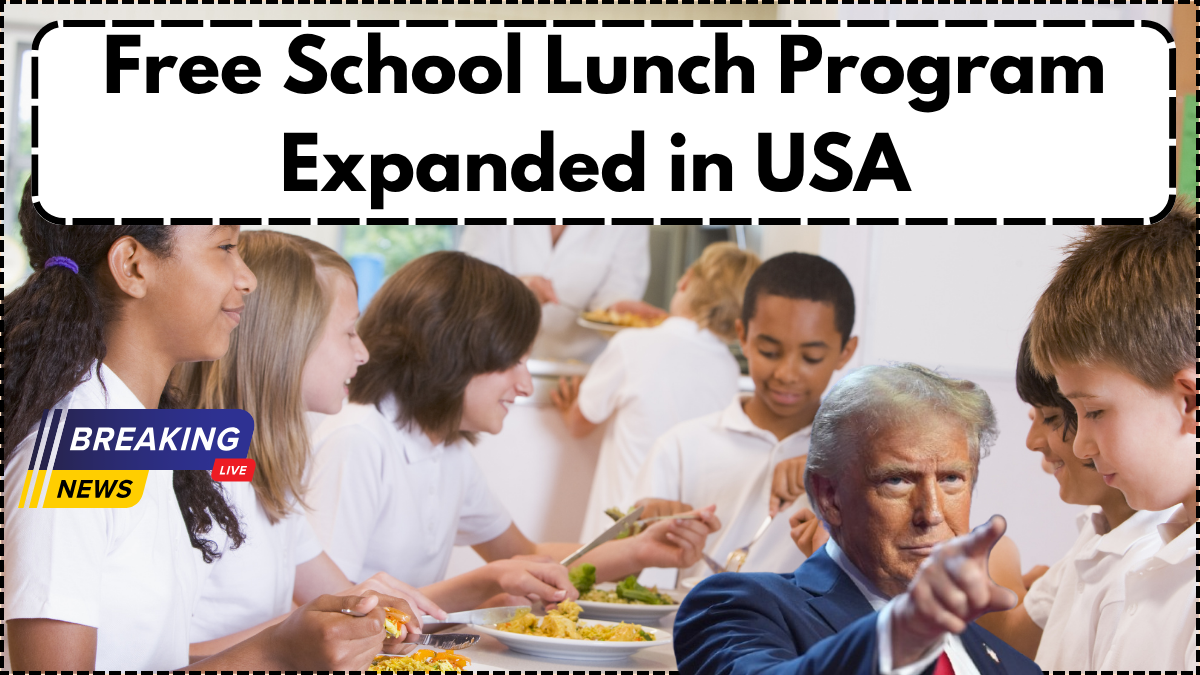The USA School Lunch Program 2025 underwent major enhancements under the guidance of the U.S. Department of Agriculture (USDA). These updates aim to improve student nutrition access and support families facing economic challenges. The USDA free meals initiative is now reaching more schools and students than ever, thanks to newly expanded eligibility and simplified application procedures.
As food insecurity remains a concern in many American households, these changes come as a timely measure to ensure that every child gets access to nutritious meals during the school day without the burden of cost. The new structure reflects a clear shift toward inclusivity, health, and administrative efficiency.

What’s New in the 2025 USDA Free Meals Guidelines
The USDA has introduced several important revisions to the free school lunch program guidelines for the 2025-2026 academic year:
- Expanded Income Thresholds: More families now qualify for free or reduced-price meals, thanks to adjusted income limits that account for inflation and regional cost-of-living differences.
- Universal Free Lunch in High-Need Areas: Schools in low-income districts can now offer universal free meals without requiring individual applications.
- Simplified Application Process: Families can now apply online with fewer documents, and schools can use direct certification through SNAP and Medicaid data.
- Healthier Meal Standards: Stricter nutritional guidelines ensure more whole grains, reduced sodium, and increased servings of fruits and vegetables.
- Year-Round Meal Support: USDA free meals are now accessible during summer months through expanded summer feeding programs.
These improvements are designed to streamline operations and reduce the administrative burden on both families and school districts.
Who Benefits from the Updated USA School Lunch Program 2025
The enhanced program is particularly beneficial for working families who fall just outside the previous income thresholds but still struggle with food costs. Children in rural and urban districts alike will gain from better access to balanced meals that support their academic performance and long-term health.
Additionally, school administrators report higher participation rates in the lunch program and reduced instances of lunch debt, which has been a persistent issue across districts. The stigma often associated with receiving free meals is also reduced with broader participation.
Key Data and Eligibility Criteria
Below is a quick reference for families and school officials regarding the updated criteria under the USA School Lunch Program 2025:
| Feature | 2024 Guidelines | 2025 Updates |
|---|---|---|
| Income Eligibility Limit | 130% of federal poverty level | 150% of federal poverty level |
| Direct Certification Sources | SNAP only | SNAP, Medicaid, TANF |
| Universal Free Lunch Eligibility | 60% low-income enrollment | 50% low-income enrollment |
| Summer Meal Access | Limited to Title I schools | Open to all qualifying districts |
| Sodium and Whole Grain Targets | Voluntary targets | Mandatory compliance for all schools |
These updates mark a significant policy shift aimed at ensuring broader, equitable access to essential nutritional support.
Looking Ahead: Impact and Implementation
States have been allocated additional funding to support smooth rollout of the updated guidelines. Training programs for school nutrition staff and software updates for meal application systems have been prioritized to reduce disruptions.
Districts are also encouraged to conduct community outreach through local events and school newsletters to ensure that families are aware of their options. These outreach efforts will be key in maximizing enrollment and preventing children from falling through the cracks.
The USDA has committed to continuous review and adaptation of the program based on data and feedback from schools, families, and advocacy groups. With these steps, the USA School Lunch Program 2025 sets a stronger foundation for educational equity and child well-being.
Conclusion
The expansion of the USA School Lunch Program 2025 reflects a strategic and compassionate move to tackle childhood hunger through practical policy. With USDA free meals now more widely available and nutritious than before, the nation takes a critical step forward in supporting the next generation. As school resumes this fall, millions of students will benefit from these enhanced meal offerings—without paperwork hurdles or stigma.
FAQ
Who is eligible for the USA School Lunch Program 2025?
Families with incomes up to 150% of the federal poverty level, and students in schools with at least 50% low-income enrollment, are automatically eligible under the new guidelines.
Do families need to apply for USDA free meals?
Not always. Many families are directly certified through participation in programs like SNAP or Medicaid. Others can apply online with simplified forms.
Are summer meals part of the 2025 expansion?
Yes. The USDA has expanded its summer feeding programs, making meals accessible even when school is out.
Will schools have to follow new nutrition rules?
Yes. Starting in the 2025-2026 school year, all participating schools must comply with updated nutrition standards set by the USDA.
How can families find out if their school participates?
Check with your local school district’s website or call the school administration office for updated information on eligibility and participation.
Click here to know more.